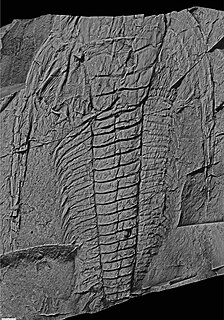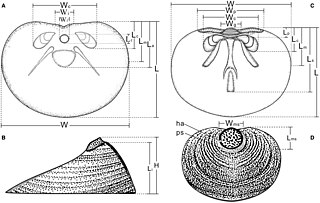The Ordovician is a geologic period and system, the second of six periods of the Paleozoic Era. The Ordovician spans 41.6 million years from the end of the Cambrian Period 485.4 million years ago (Mya) to the start of the Silurian Period 443.8 Mya.

Archaeocyatha is a taxon of extinct, sessile, reef-building marine sponges that lived in warm tropical and subtropical waters during the Cambrian Period. It is believed that the centre of the Archaeocyatha origin is now located in East Siberia, where they are first known from the beginning of the Tommotian Age of the Cambrian, 525 million years ago (mya). In other regions of the world, they appeared much later, during the Atdabanian, and quickly diversified into over a hundred families. They became the planet's very first reef-building animals and are an index fossil for the Lower Cambrian worldwide.

Microdictyon is an extinct armoured worm-like animal coated with net-like scleritic plates, known from the Early Cambrian Maotianshan shale of Yunnan China and other parts of the world. Microdictyon is part of the ill-defined taxon – Lobopodia – that includes several other odd worm-like animals that resembling worm with legs, such as Hallucigenia, Onychodictyon, Cardiodictyon, Luolishania, and Paucipodia. The isolated sclerites of Microdictyon are known from other Lower Cambrian deposits. Microdictyon sclerites appear to have moulted; one sclerite seems to have been preserved during ecdysis.

John William Salter was an English naturalist, geologist, and palaeontologist.

Olenellina is a suborder of the order Redlichiida of trilobites that occurs about halfway during the Lower Cambrian, at the start of the stage called the Atdabanian. The earliest trilobites in the fossil record are arguably Olenellina, although the earliest Redlichiina and Eodiscina follow quickly. The suborder died out when the Lower passed into the Middle Cambrian, at the end of the stage called Toyonian. A feature uniting the Olenellina is the lack of rupture lines in the headshield, which in other trilobites assist the periodic moulting, associated with arthropod growth. Some derived trilobites have lost facial sutures again, but all of these are blind, while all Olenellina have eyes.
Dolerorthis is an extinct genus of hesperorthid brachiopod. The type species of this genus, D. interplicata, was described from the Silurian (Telychian) Osgood Formation. Other species belonging to this genus are known from the Ordovician and Silurian of Europe, Kazakhstan, China and Argentina. It was roughly 4 centimetres (1.6 in) across.

Orthida is an extinct order of brachiopods which appeared during the Early Cambrian period and became very diverse by the Ordovician, living in shallow-shelf seas. Orthids are the oldest member of the subphylum Rhynchonelliformea, and is the order from which all other brachiopods of this group stem. Physically they are usually strophic, with well-developed interareas. They also commonly have radiating ribs, sulcus, and fold structures. Typically one valve, often the brachial valve, is flatter than the other. The interior structure of the brachial valves are usually simple. In shape they are sub-circular to elliptical, with typically biconvex valves.

Strophomenida is an extinct order of articulate brachiopods which lived from the lower Ordovician period to the mid-Carboniferous period. Strophomenida is part of the extinct class Strophomenata, and was the largest known order of brachiopods, encompassing over 400 genera. Some of the largest and heaviest known brachiopod species belong to this class. Strophomenids were among the most diverse and abundant brachiopods during the Ordovician, but their diversity was strongly impacted at the Late Ordovician mass extinction. Survivors rediversified into new morphologies in the Silurian, only to be impacted once again at the Late Devonian mass extinction. They finally died out in the Carboniferous period.
The small shelly fauna, small shelly fossils (SSF), or early skeletal fossils (ESF) are mineralized fossils, many only a few millimetres long, with a nearly continuous record from the latest stages of the Ediacaran to the end of the Early Cambrian Period. They are very diverse, and there is no formal definition of "small shelly fauna" or "small shelly fossils". Almost all are from earlier rocks than more familiar fossils such as trilobites. Since most SSFs were preserved by being covered quickly with phosphate and this method of preservation is mainly limited to the late Ediacaran and early Cambrian periods, the animals that made them may actually have arisen earlier and persisted after this time span.

Brachiopods, phylum Brachiopoda, are a phylum of trochozoan animals that have hard "valves" (shells) on the upper and lower surfaces, unlike the left and right arrangement in bivalve molluscs. Brachiopod valves are hinged at the rear end, while the front can be opened for feeding or closed for protection. Two major groups are recognized, articulate and inarticulate. The word "articulate" is used to describe the tooth-and-groove features of the valve-hinge which is present in the articulate group, and absent from the inarticulate group. This is the leading diagnostic feature (fossilizable), by which the two main groups can be readily distinguished. Articulate brachiopods have toothed hinges and simple opening and closing muscles, while inarticulate brachiopods have untoothed hinges and a more complex system of muscles used to keep the two valves aligned. In a typical brachiopod a stalk-like pedicle projects from an opening in one of the valves near the hinges, known as the pedicle valve, keeping the animal anchored to the seabed but clear of silt that would obstruct the opening.

The origin of the brachiopods is uncertain; they either arose from reduction of a multi-plated tubular organism, or from the folding of a slug-like organism with a protective shell on either end. Since their Cambrian origin, the phylum rose to a Palaeozoic dominance, but dwindled during the Mesozoic.
The Kirengellids are a group of problematic Cambrian fossil shells of marine organisms. The shells bear a number of paired muscle scars on the inner surface of the valve.

Acrotretida is an extinct order of linguliform brachiopods in the class Lingulata. They lived from the Lower Cambrian to the Middle Devonian. Acrotretida contains the sole superfamily Acrotretoidea. Many acrotretides have a tall and conical ventral valve with a pedicle opening at the apex, while the musculature is simplified relative to other linguliforms. The shell has a rounded outline, and is usually phosphatic like other linguliforms.

Lingulella is a genus of phosphatic-shelled brachiopod. It is known from the Middle Cambrian Burgess Shale (Canada) to the Upper Ordovician Bromide Formation in North America. 346 specimens of Lingulella are known from the Greater Phyllopod bed, where they comprise 0.66% of the community.

Lingulida is an order of brachiopods.
Stage 10 of the Cambrian is the still unnamed third and final stage of the Furongian series. It follows the Jiangshanian and precedes the Ordovician Tremadocian Stage. The proposed lower boundary is the first appearance of the trilobite Lotagnostus americanus around 489.5 million years ago, but other fossils are also being discussed. The upper boundary is defined as the appearance of the conodont Iapetognathus fluctivagus which marks the beginning of the Tremadocian and is radiometrically dated as 485.4 million years ago.

Armin Aleksander Öpik was an Estonian paleontologist who spent the second half of his career at the Bureau of Mineral Resources in Australia.
Acrotheloidea is a superfamily of Discinid brachiopods, alternatively ascribed to the lingulids—for a discussion of discinid taxonomy, see Discinida.

The Random Formation is a rock unit in Newfoundland dating to the early Cambrian period, dominated by tidal quartz arenites deposited in a near-shore environment, but also incorporating intertidal and open-shelf deposits, including glauconitic and mud-cracked mudstones, and red channel sandstones. It was deposited quickly and is approximately 175 m thick. The Blue Pinion Formation was originally recognized as a separate formation, but is now interpreted as an expression of the Random Formation.

The Bliss Formation is a geologic formation that is exposed in southern New Mexico, west Texas, and southeastern Arizona. It preserves fossils dating back to the late Cambrian to early Ordovician periods.













